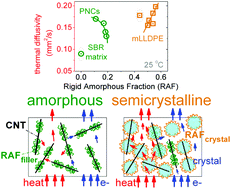Effects of CNTs on thermal transitions, thermal diffusivity and electrical conductivity in nanocomposites: comparison between an amorphous and a semicrystalline polymer matrix†
Abstract
Two series of polymer nanocomposites (PNCs) based on amorphous styrene-butadiene rubber (SBR) and semicrystalline linear low-density polyethylene (PE) matrices were filled with 2–15 wt% carbon nanotubes (CNT) and were studied by employing calorimetry, dielectric spectroscopy and laser flash analysis. The electrical conductivity, σ, increased with CNT loading and similar values were exhibited for the two matrices, uniquely depending on the concentration of the CNTs, suggesting practically no effects of the crystalline fraction (CF) on σ. For both types of matrix, a fraction of the polymer was found to be immobilized (rigid amorphous fraction, RAF). For the amorphous SBR, the RAF in PNCs originates uniquely from the presence of the filler (RAFfiller up to 0.19 wt). On the other hand, for the semicrystalline PE, the RAF is significantly larger (0.4–0.6 wt) due to the severe contribution of the RAF around the crystals (RAFcrystal). The thermal diffusivity, α, is quite low in both types of PNCs and exhibits higher values in the semicrystalline matrix (PE-based PNCs). Our results suggest that in these PNCs, heat transport mechanisms are activated mainly in the crystalline domains, more so with the additive contribution of the RAFcrystal. In the amorphous SBR-based PNCs, heat transport is facilitated mainly by CNTs, whereas the RAFfiller is found to be a good measure of the thermal resistance behavior of CNT/polymer interphases and consequently, of thermal diffusivity. Direct correlation of the results obtained by the three techniques with each other revealed the systematic dependence of α on the amount of RAF in each matrix; the α(RAF) trends, however, are different for the two matrices. Furthermore, the results suggest that the two RAFs exhibit different structural characteristics, e.g. the RAFcrystal exhibits a more ordered structure than the RAFfiller; this issue is still an open debate in the literature.



 Please wait while we load your content...
Please wait while we load your content...